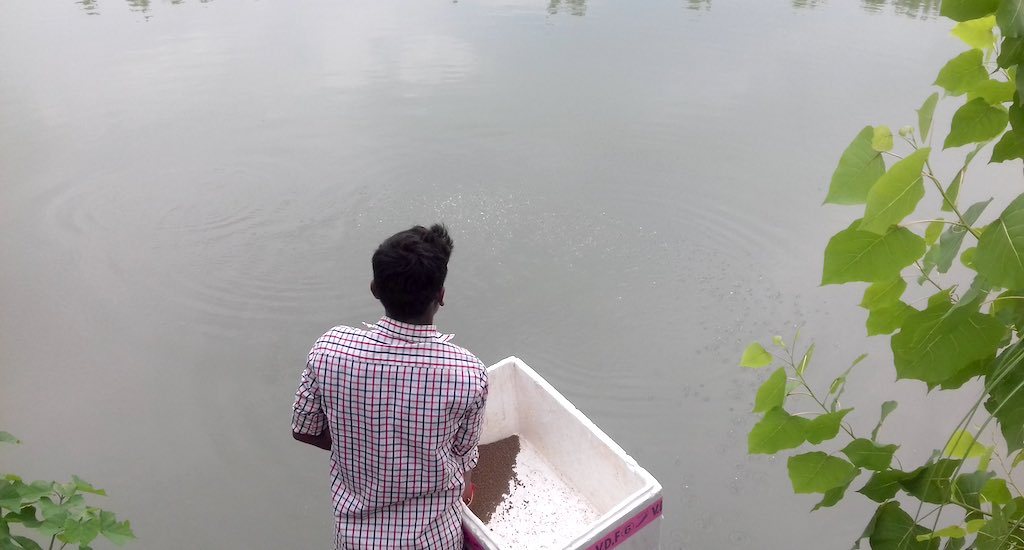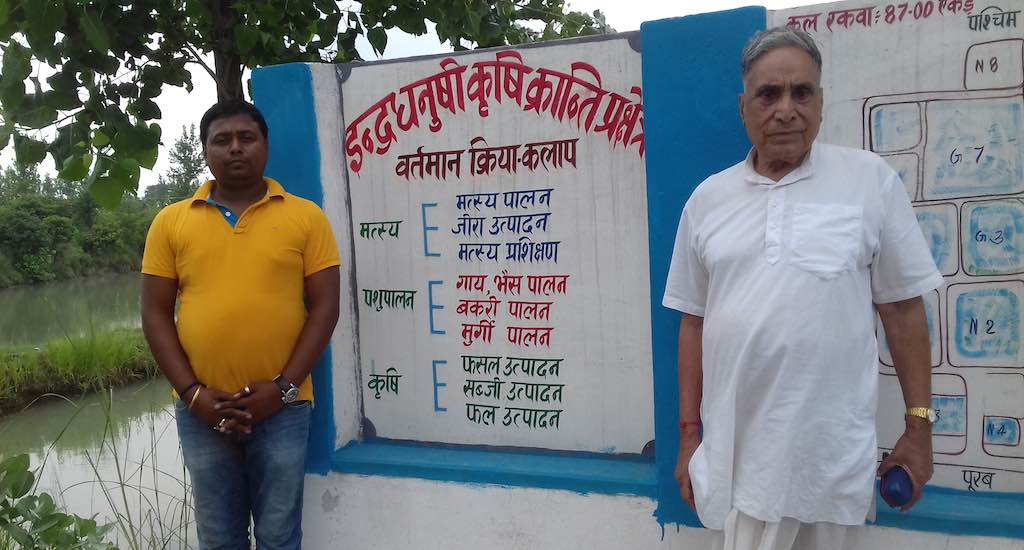Wetlands Are ‘Wastelands’? Here’s How One Bihar Village Proved Us All Wrong
A group of farmers have converted a shunned wetland to practice fish farming, agro-forestry and horticulture, providing employment and livelihood opportunities to impoverished villagers. Mohd Imran Khan takes a closer look.

Mulki Devi and Satrughan Mahto, both marginal farmers from Mutlupur, no longer worry about their wetlands remaining unused.
“I never dreamt that this wetland would turn productive in my lifetime,” gushes Mulki Devi. Satrughan Mahto is happy that his wetland, which was put to no use, is now a part of an integrated farm, earning him an income. He is also confident this income will increase in the future.
Mutlupur in Muzaffarpur district of Bihar is flood-prone, as the Gandak River and Bagmati River skirt the village on the northern and southern sides, respectively. The village had 87 acres of low-lying wetland, locally known as chaur, which was considered a blight since they were not productive in any way.
But a group of farmers have turned chaurs productive and turned them into a resource of livelihood.
Derelict wetland to integrated farm
It was Gopalji Trivedi, former vice-chancellor of Rajendra Prasad Central Agricultural University at Pusa, now a farmer in Mutlupur, who convinced the farmers to use the barren wetland for agricultural purposes.
“I persuaded the farmers to change the face of the low-lying Korlaha Chaur. Despite the initial reluctance, they joined hands and the wetland that was derelict for decades is the village’s centre of attraction now,” the octogenarian told VillageSquare.in.
22 farmers including Trivedi, whose landholdings ranged from small to big, joined hands to develop the wetland. They formed an association and an advisory committee to manage the development process.
The group consulted veterinary, agricultural, fishery and horticultural experts to use the latest technology and developments in integrated farming.
“Our focus is on fisheries, as it is the most suitable for wetland use. We have integrated poultry, a goat farm and a dairy unit into our development plan,” Trivedi said.
Fisheries – The mainstay

In the Korlaha Chaur, there are 17 big ponds, the largest spread over 14 acres. Nearly 50 local residents, mostly youth, fish in the chaur’s ponds.
“Every day I take fresh fish from the chaur and sell them in villages near Mutlupur. Now I can earn my livelihood, and I have stopped thinking of migrating to other states for work. There are dozens like me here, who are selling fish as it is a profitable business,” Mukesh Kumar, a Dalit youth, told VillageSquare.in.
Ramchander Prasad said that availability of fishes in the big ponds has made it easy for youth like him to make a living locally.
According to officials in Bihar’s fisheries department, the state requires over 600,000 tons of fish annually, whereas the production is less than 500,000 tons. But more than 30,000 tons of fish from Bihar are sold in West Bengal and exported to Nepal. Presently, the per capita annual consumption of fish in Bihar is 7.7 kg compared to the national average of 10 kg per person.
Bihar is not producing adequate fish to fill its own demand despite having plenty of water resources including wetlands. The state government has decided to work towards making Bihar a fish-surplus state by 2020.
“Thousands of hectares of wetlands across the state could be used for aquaculture. This can not only turn Bihar into a fish-surplus state but make it a main supplier of fish across the country,” Shivraj Singh, manager of a fishery, told VillageSquare.in.
Agro-forestry
In a bid to create a green cover, the farmers have planted over 16,000 timber saplings.
Hundreds of fruit-bearing trees such as jamun (Java plum), jackfruit, Indian gooseberry, ber (Indian date), sweet lime, mango, guava and lemon bring them regular income. Vegetables and food grains are also cultivated. “Our goal is to utilise every bit of our natural resources to produce food,” Trivedi pointed out.
Agriculture experts had repeatedly said that dry land agriculture is unsuitable for wetland areas. But the farmers are happy that they have succeeded in their experiment. Mangala Rai, the former agriculture advisor to the chief minister of Bihar and former Director General of Indian Council of Agriculture Research (ICAR), has lauded the farmers for being an inspiration to others.
As the benefits of agriculture and horticulture in the chaur are obvious, people envy Korlaha, said Mulki Devi with a light-hearted smile.
Social change

The wetland had been a haven for anti-social activities for five years now. The negative outlook associated with it has changed, and it is now a symbol of prosperity.
The development has created employment opportunities for many of the local youth, besides being a source of income for the farmers.
According to Singh, the plan is to generate 200 jobs in the coming years, besides indirect employment opportunities for neighbouring villagers.
Replicating the Mutlupur model
There are 941,000 hectares of chaur in Bihar, which remain submerged for six to seven months a year. Of these, more than 500,000 hectares have been declared suitable for fishing. “Despite the large population of traditional Shahni (caste) fishermen, only 500 acres are being used for fish farming,” an official of the state fisheries department told VillageSquare.in.
Sukhdeo Rai, a farmer, said wetlands are not wastelands; they can pave the way for prosperity in rural areas if developed along such lines.
Impressed by the success of Korlaha Chaur development, another group of farmers is in talks with Singh’s farm to develop their 70 acres of wetland.
According to Mangala Rai, if managed efficiently, wetlands of Bihar can be turned into an agricultural goldmine. He stresses the need to adopt latest scientific and technological practices for better management of wetlands in the state.
“If we can develop wetlands for integrated farming in Mutlupur, people in flood-prone villages in north Bihar, particularly in Seemanchal, Koshi and Mithilanchal regions, can do the same. Use of wetlands for agriculture and fisheries would change the face of rural Bihar. It can also be an example for the country, ending the hopelessness of farmers,” Trivedi told VillageSquare.in.
Mohd Imran Khan is a journalist based in Patna.
Adapted from an article originally published on VillageSquare.in. Subscribe to VillageSquare’s weekly update on the website for more stories from rural India.
Like this story? Or have something to share?
Write to us: [email protected]
Connect with us on Facebook and Twitter.
NEW: Click here to get positive news on WhatsApp!
If you found our stories insightful, informative, or even just enjoyable, we invite you to consider making a voluntary payment to support the work we do at The Better India. Your contribution helps us continue producing quality content that educates, inspires, and drives positive change.
Choose one of the payment options below for your contribution-
By paying for the stories you value, you directly contribute to sustaining our efforts focused on making a difference in the world. Together, let’s ensure that impactful stories continue to be told and shared, enriching lives and communities alike.
Thank you for your support. Here are some frequently asked questions you might find helpful to know why you are contributing?


This story made me
-
97
-
121
-
89
-
167











